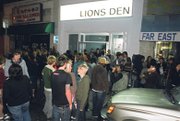Retailers Gamble With Fashion in Chinatown
George Yu thought that hosting a fashion show on the streets of Los Angeles’ Chinatown could be a stroke of marketing genius. He also knew it was a gamble.
The purpose of the fashion show, held on the evening of Dec. 8, 2001, was to draw attention to the budding fashion scene on Chun King Road, where designers Loy and Ford kept offices. But Yu, who is executive director of the Chinatown Business Improvement District, knew that some of Chinatown’s more traditional groups frowned on bringing outsiders to the traditionally immigrant neighborhood.
Still, Yu decided to take the risk. The show featured models wearing traditional Chinese costumes as well as new fashions by Los Angeles designers including David Cardona. By the time show producer Fashion Business Inc. wrapped up the event, Yu saw that the crowd’s applause not only came from fashion luminaries in the audience such as supermodel Tyra Banks, but also from scores of residents.
The Chinatown fashion scene has gone through expansions and contractions. Designer Alicia Lawhon staged a show on Chun King Road back in October 1999. Loy and Ford held a runway show there in April 2000, when they first opened a store in the area.
Raymond Tseng, owner of Chinatown boutique Lions Den, is one of the area’s newcomers. The retailer acknowledged that the area’s fashion retail potential has not yet been realized.
But upcoming development may bring a new crowd to Chinatown. By the end of 2006, Oakland, Calif.– based Bond Cos. will begin construction of Blossom Plaza. It’s a 230-residential-unit mixed-use building with 60,000 square feet of retail at the former site of Little Joe’s restaurant at Broadway and College Street.
In 2007, Chicago’s Equity International plans to build 280 residential units and 20,000 square feet of retail at Gateway Plaza, to be located on the corner of Broadway and Cesar Chavez Avenue.
By 2007, the Riboli family, owners of Chinatown’s San Antonio Winery, will build 30,000 square feet of loft space on the Capital Mills building in the 1000 block of North Spring Street.
New loft dwellers may bring some new blood to Chinatown, but Yu isn’t hoping for radical change. “Our strategic plan was not to change the character of Chinatown,” he said. “It was to make it more business friendly. The character of the neighborhood is what holds the charm for new residents and businesspeople.”
Chinatown’s sometimes-gritty charm attracted fashion designer Frank Ford, of Loy and Ford, which moved to Los Angeles’ Echo Park neighborhood in 2002. “[Chinatown] is a nice place for fashion designers who are on Step 1 of their careers. There’s a relaxed and charming flair in this area, and there’s also the low rent and the quick ride to the garment district.” But, the designer said, Chinatown’s lack of parking spaces and the buildings’ relatively small square footage were stumbling blocks to running a design studio. cribed as an up-and-coming label. Ford and Loy, who opened their office in Los Angeles in 1999, sell their line at retailers including Barneys New York and Neiman Marcus.
Los Angeles designer Andrae Gonzalo opened his store, Forget it Jake, in Chinatown in 2002, but closed it last June days before he left to join the line-up in Bravo’s fashion reality show “Project Runway.”
Gonzalo has returned to Los Angeles and returned to designing his AndraeGonzalo line, but he has no immediate plans to return to retailing in Chinatown.
“People generally go to Chinatown to find cheap bargains on things imported from the mainland. This impulse is antithetical for a business trying to sell specialty fashion apparel,” he said. “[Still,] everyone has high expectations for urban renewal, and when every luxury loft is occupied, there may be some hope for fashion retail in Chinatown.”
Still, Chinatown’s unique appeal convinced Wendy Yao to open Ooga Booga, a boutique that sells art-inspired fashion on Broadway. “There’s a sense of community here,” she said. “And Chinatown will always have a little grit. It will never be sanitized like Pasadena.”
The availability of relatively inexpensive commercial real estate helped convince Yao to open Ooga Booga in late 2004. Commercial real estate prices range from $1.50 per square foot for second-floor office space on Broadway, one of the neighborhood’s main thoroughfares, to $5 per square foot on Broadway’s street level, according to Yu.
Art lovers browsing Chun King Road’s galleries make up the majority of Ooga Booga’s customers. Yao sells art, CDs and magazines as well as fashion. Top-selling fashion includes ruched T-shirts by Los Angeles– based Oumi, which retail for $136. Sweatshirts by New York–based Opening Ceremony sell well. Its sweat shirts with a lattice pattern cost $80.
The neighborhood also attracted fashion designer Paul Magalad, who opened his store Birth From Perth in late 2005. (A familiar face in Chinatown, Magalad also used Chun King Road as a runway, back in April 2003, for a show featuring his San Paredes label.)
The area also intrigued first-time retailer Tseng, who opened Lions Den in September 2005.
He intends his 1,200-square-foot boutique to reflect the Asian American youth experience. He sells sneakers with a hip-hop/skateboard edge. Sneakers manufactured by RTFT bear an argyle pattern and cost $70. Women buy sneakers manufactured by Gwen Stefani’s L.A.M.B. label, whose “Baby” shoe costs $134.
T-shirts designed by Los Angeles–based company The Hundreds sell well. These tees, $24, often feature parodies of such brand-name logos as Tide. A top seller for women is the tops by English company Box Fresh. Its wool shirt featuring jade and brown stripes costs $84.
Lions Den clothes are produced all over the world, but customers buy the streetwear for the sake of purchasing clothes with a little Chinatown pride, according to Tseng and his sales associate Ian Alcalde. “People want to buy something that represents themselves and Los Angeles,” Alcalde said.






















